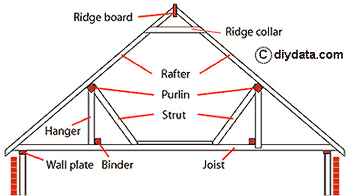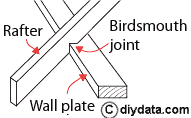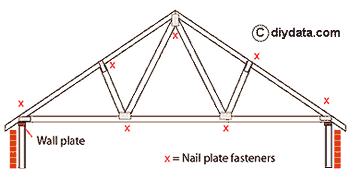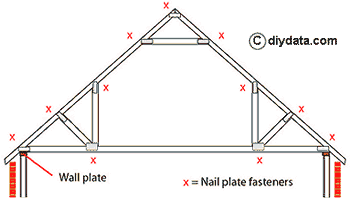Pitched roof construction
There are two basic methods of pitched roof construction;
- A 'cut roof' - this is the traditional method of cutting the timber on site and building up the roof using rafters, ridge boards, joists and purlins etc - the exact details being determined by the size of roof, size of timbers etc.
- A 'truss roof' - using factory made trusses which are delivered to site complete and just erected.
Current day building regulations require detailed calculation of the stresses, timber size etc used in roof construction, so factory made trusses are becoming the standard practice where all this can be worked out on a computer.
A cut roof
 In simple terms this type of roof
consists of rafters and joists. The joists prevent the outward spread of the rafters/walls, and conveniently give support for the ceiling below.
In simple terms this type of roof
consists of rafters and joists. The joists prevent the outward spread of the rafters/walls, and conveniently give support for the ceiling below.
The size of rafter timbers will depend upon their length from the wall plate to the ridge, the type of roof covering and whether purlins are incorporated in the roof. It is more economical to keep the cross section of the rafters down, however where an open roof space is needed, larger rafters will be necessary. Typical rafter spacing is 400mm (16 inches), closer spacing will allow small section rafters and batten, that are fixed to the rafters to locate/fix the slates or tiles, to be used. The wider the gap between the rafters, the thicker the rafter and lath timbers need to be.
Rafters are nailed to a wall plate at the top of each supporting walls, these are normally 100x75mm (4x3 inches) timber embedded on cement mortar on top of the inner skin of a cavity wall, or the inner part of a solid wall. The wall plate timbers along the top of each wall should be joined with a half lap joint where they meet.
 Each rafter has a small triangular section (referred to as 'birdsmouth joints') cut out of them to allow them to fit neatly over the wall plate. The top of the rafter is cut at an angle and nailed to the ridge board, typically 175mmx32mm (7x21/2 inch) mounted vertically.
Each rafter has a small triangular section (referred to as 'birdsmouth joints') cut out of them to allow them to fit neatly over the wall plate. The top of the rafter is cut at an angle and nailed to the ridge board, typically 175mmx32mm (7x21/2 inch) mounted vertically.
Purlins, and the associated struts, are used to give some additional support for the rafters. The purlins run at right angles to the rafters, the associated struts are positioned under every forth (or so) rafter to attach to a joist above a supporting wall below.
Hangers, in conjunction with a longitudinal binder running at right angles to the joists, are used to help hold the ceiling up. Each hanger is nailed between the every fourth (or so) rafters and the joist below. The larger the joists size, the less likely there will be a need for hangers.
Collars, ridge collars and/or collars further down the rafters, are sometimes used to provide additional binding between the rafters on both sides of the roof. Where used, they are usually fixed to an occasional pair of rafters along the roof.
No part of a timber roof should ever be cut, modified, remove or the covering of the roof changed (i.e. replacing a slate roof covering by a concrete tile covering) without consulting a structural engineer.
A truss roof
 A truss roof is made up of a number of factory made frames (or trusses) each of which which combine the joist, rafter and struts. The illustration to the right shows a typical truss for a simple Duo ridge roof.
A truss roof is made up of a number of factory made frames (or trusses) each of which which combine the joist, rafter and struts. The illustration to the right shows a typical truss for a simple Duo ridge roof.
Each modern roof truss is designed and made for a particular position in the roof structure and is made up of butt jointed timber lengths typically nailed together using plate fastenings - no type of timber joint being used. Historically truss timbers have been bolted together, or mortise and tenoned and then pegged.
 As each truss is designed to form part of the complete roof structure, they should never be cut, modified or their use changed (i.e. replacing a slate roof covering by a concrete tile covering) without consulting a structural engineer.
As each truss is designed to form part of the complete roof structure, they should never be cut, modified or their use changed (i.e. replacing a slate roof covering by a concrete tile covering) without consulting a structural engineer.
The illustration to the right shows an Open Plan truss design incorporating an area for a room in the roof space. Various other truss designs are available for different uses.
